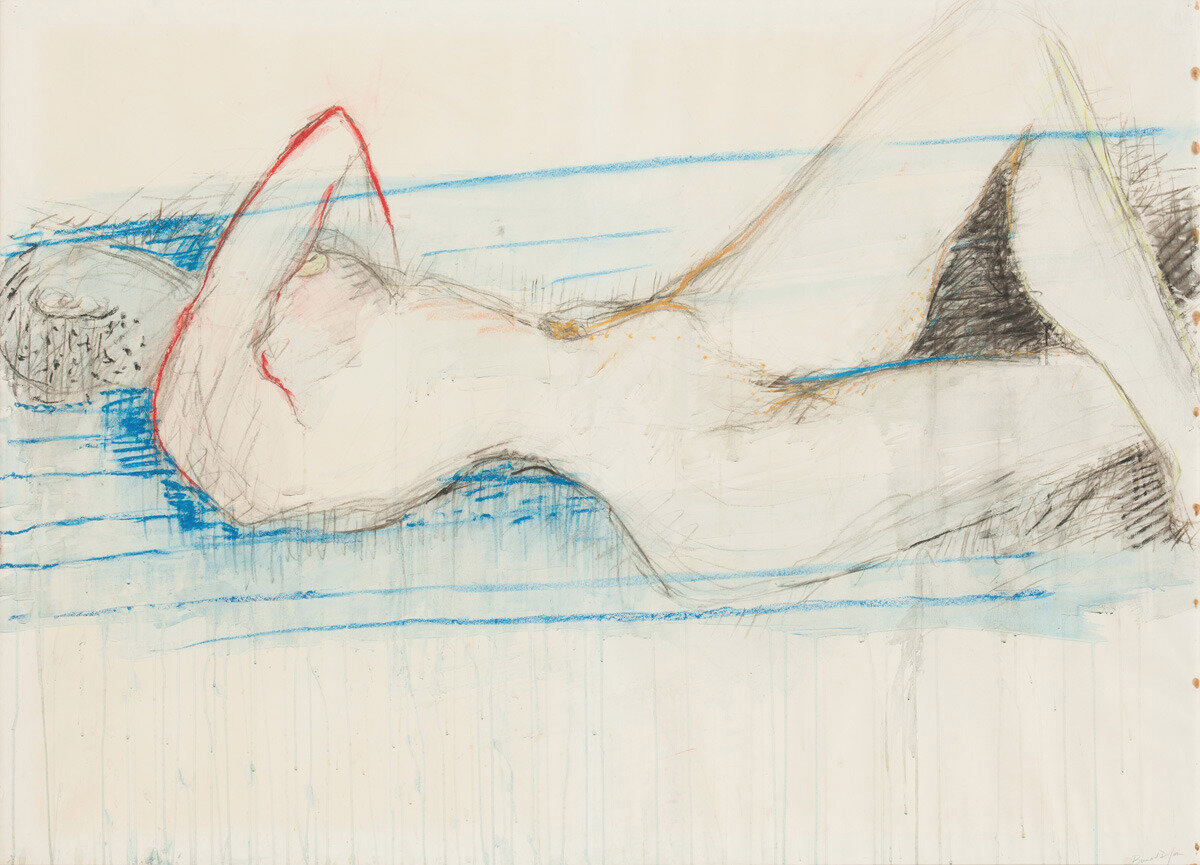
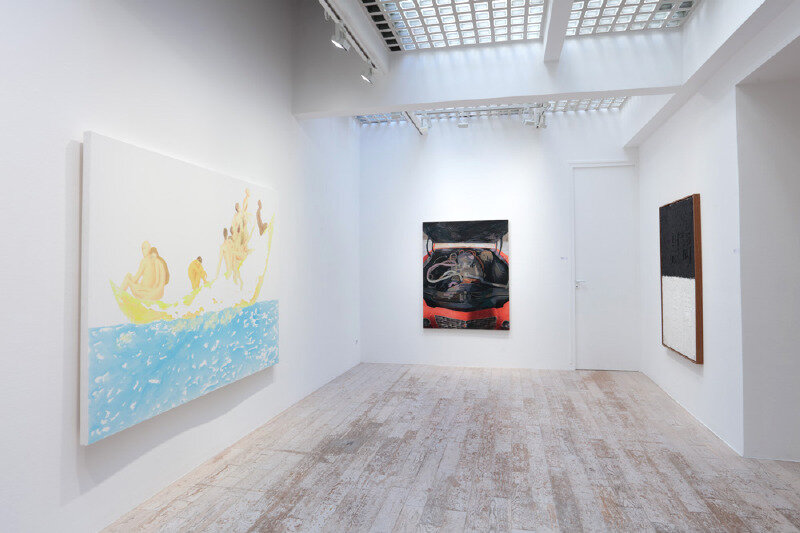
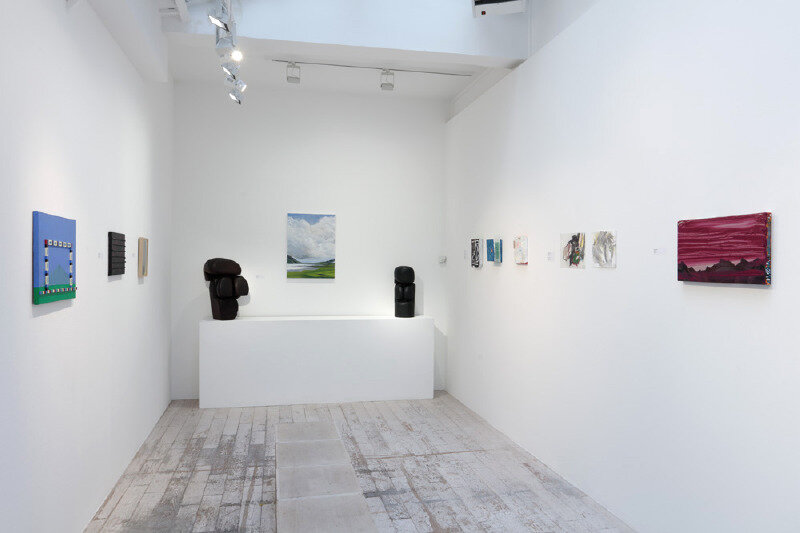
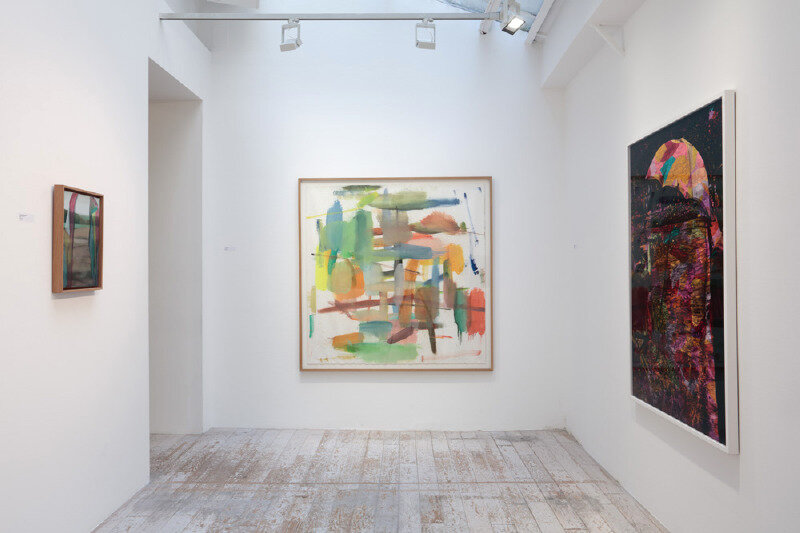
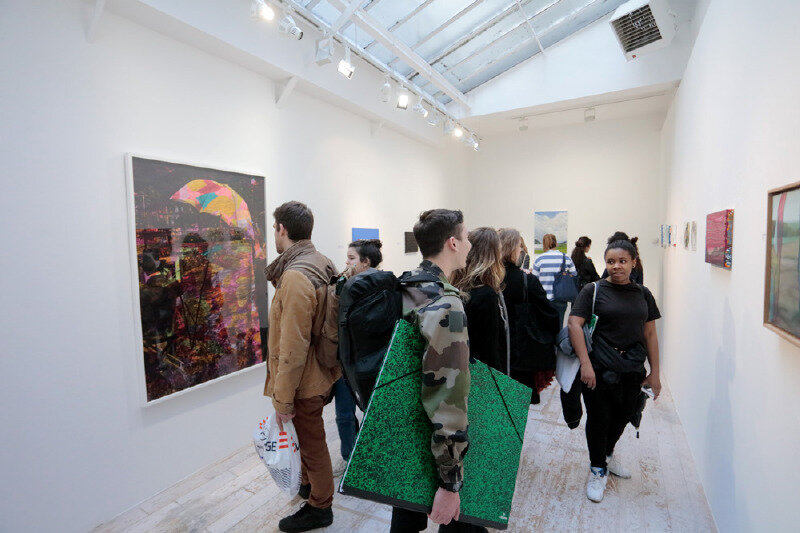
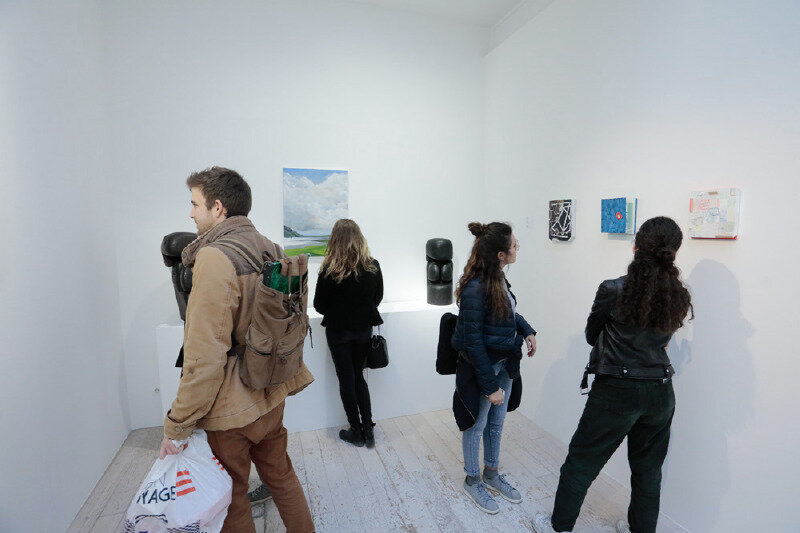
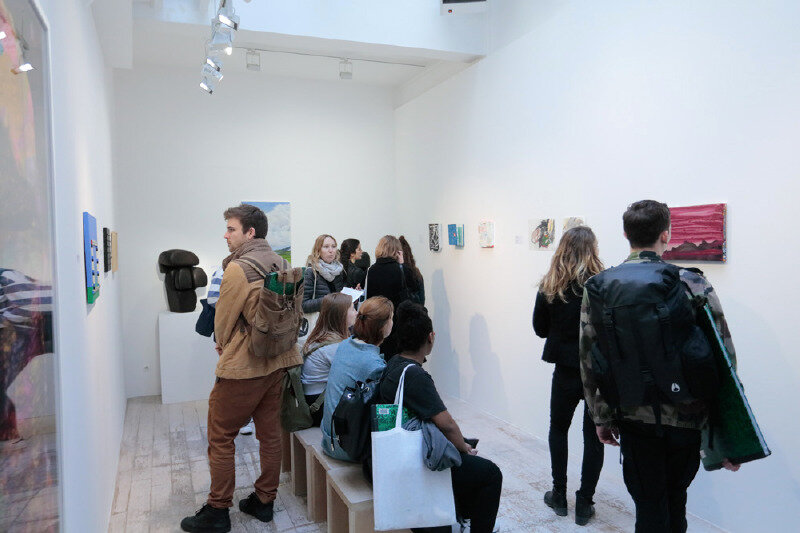

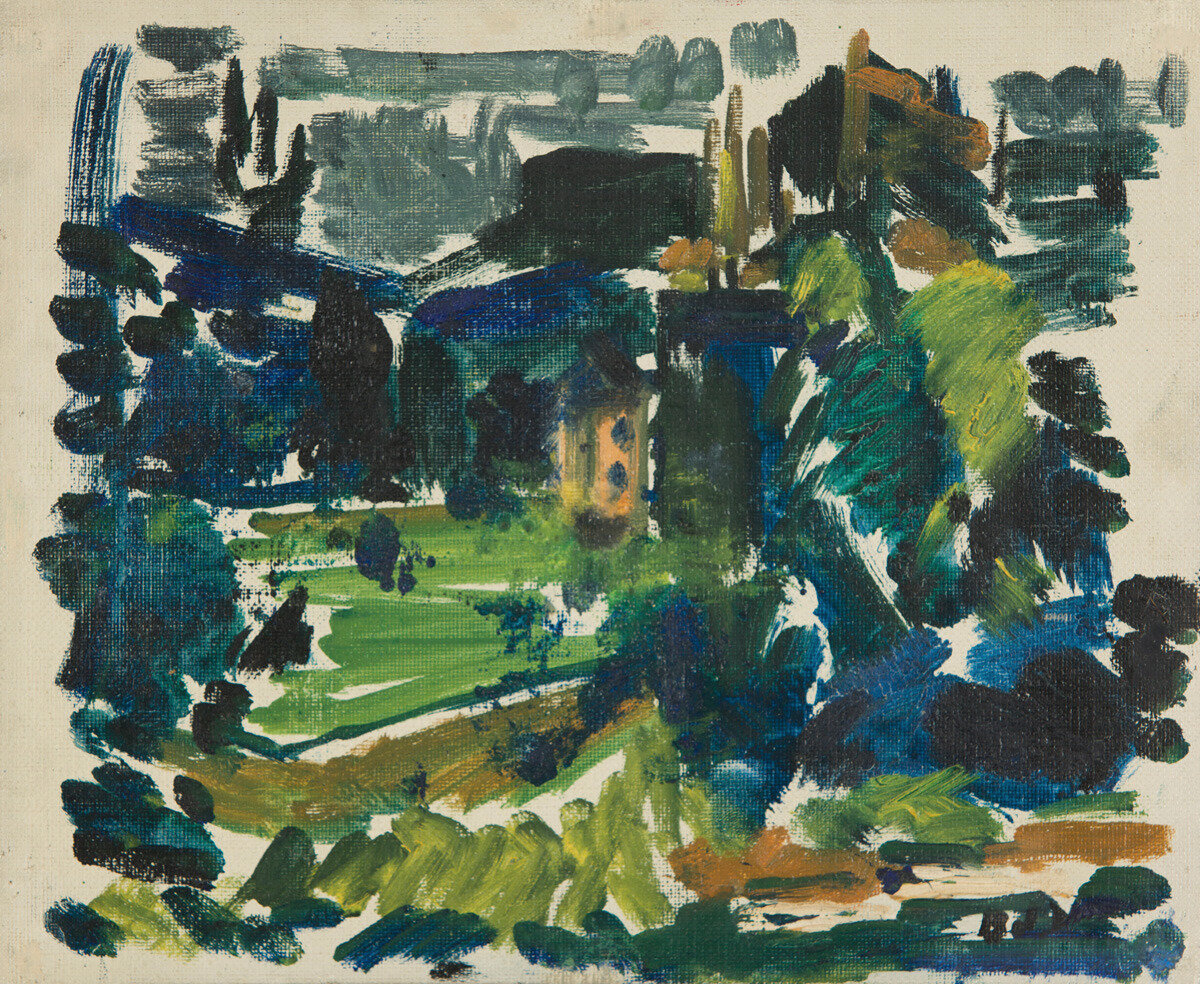
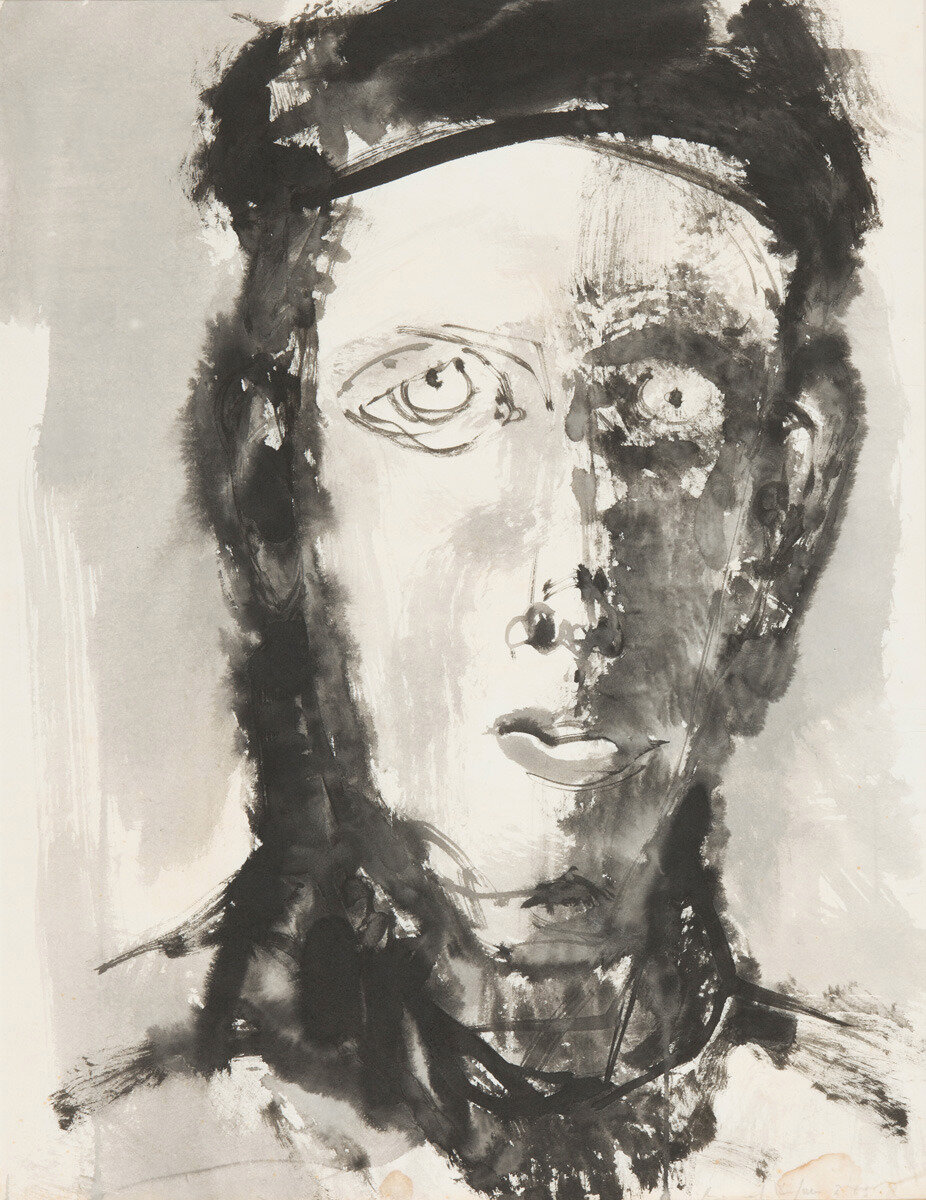

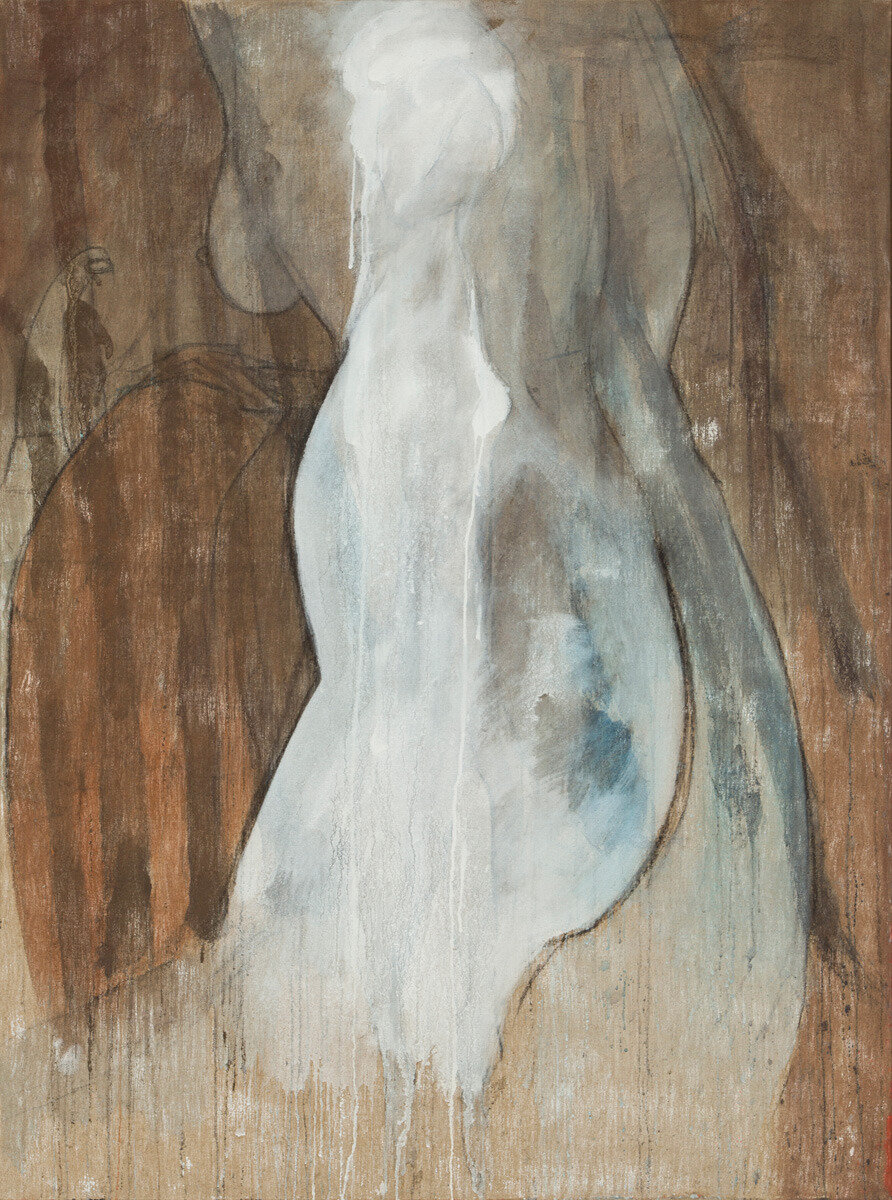


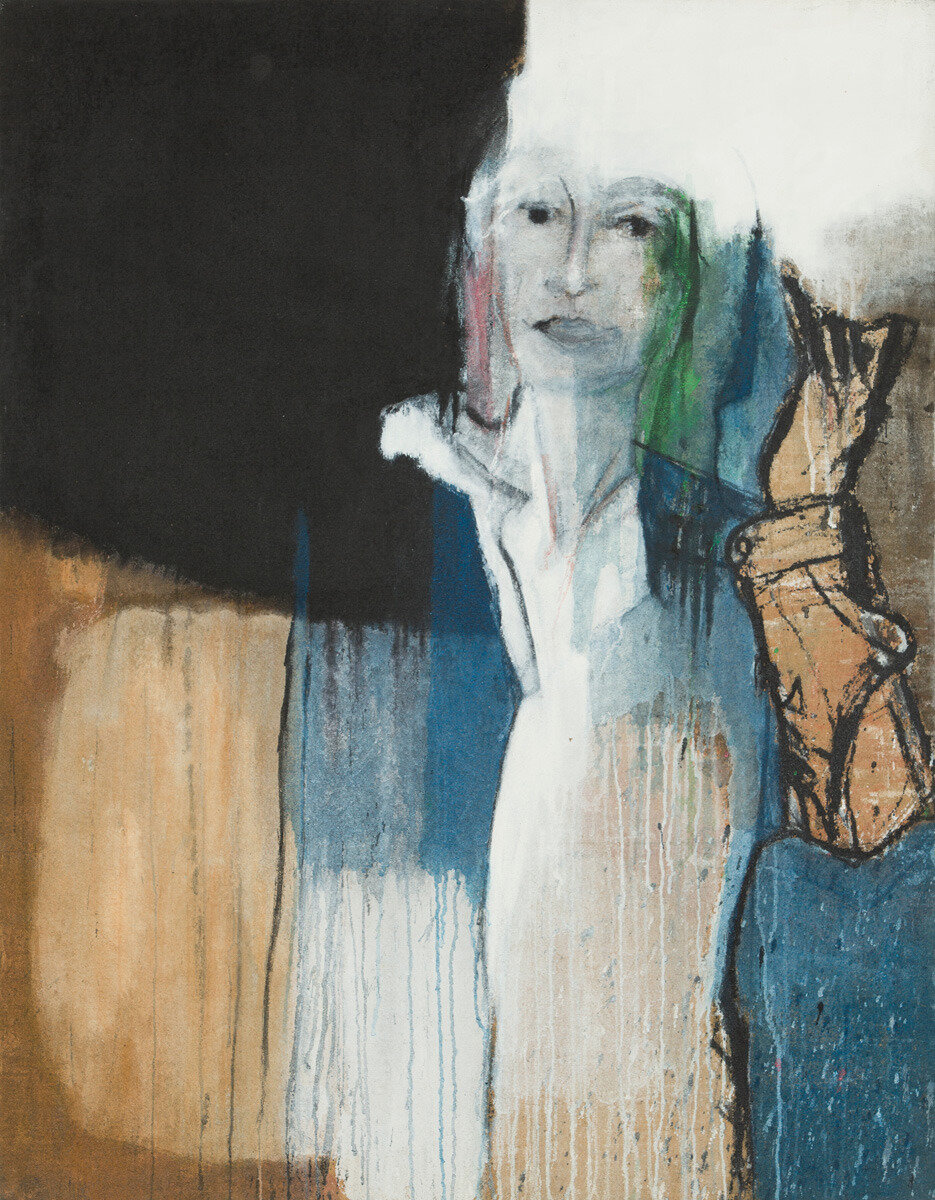


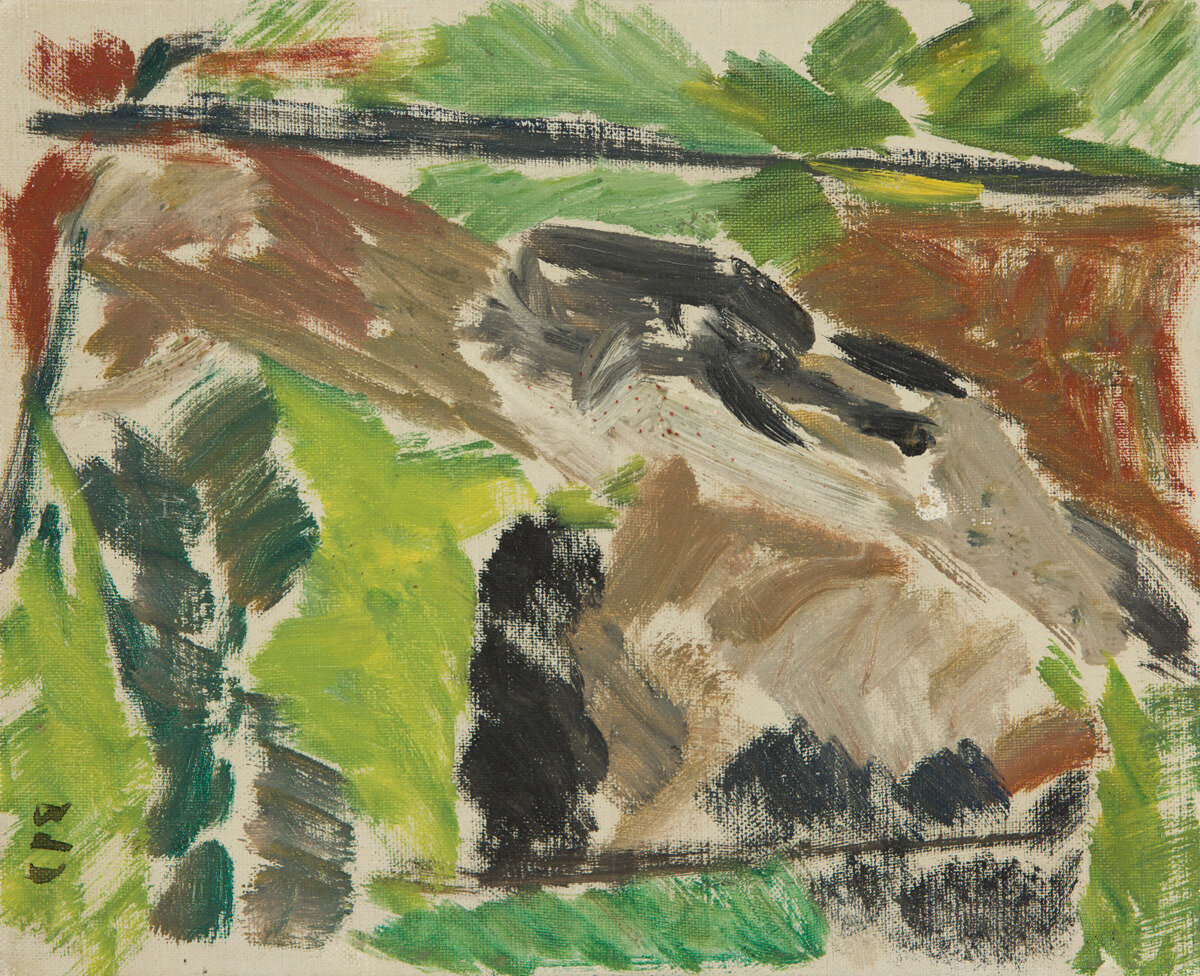
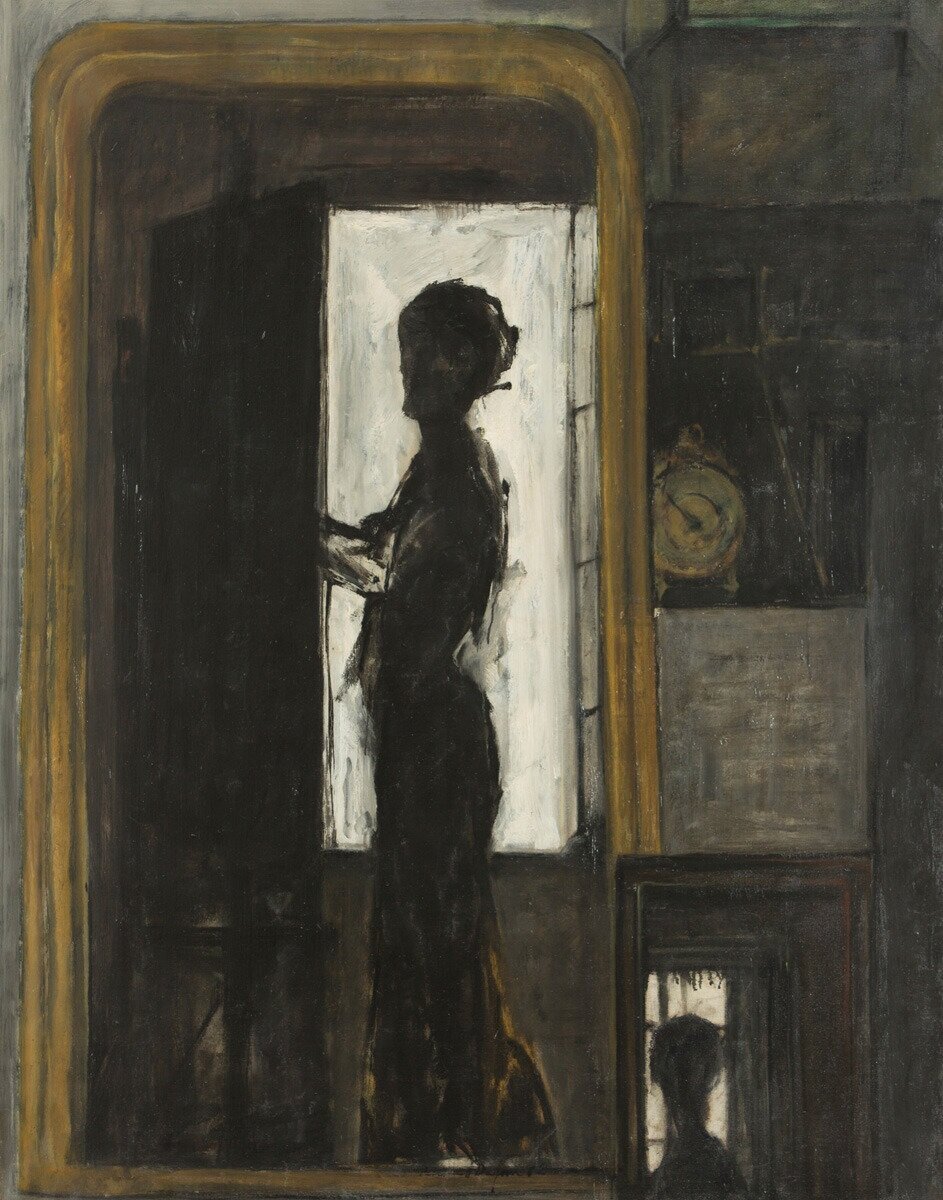
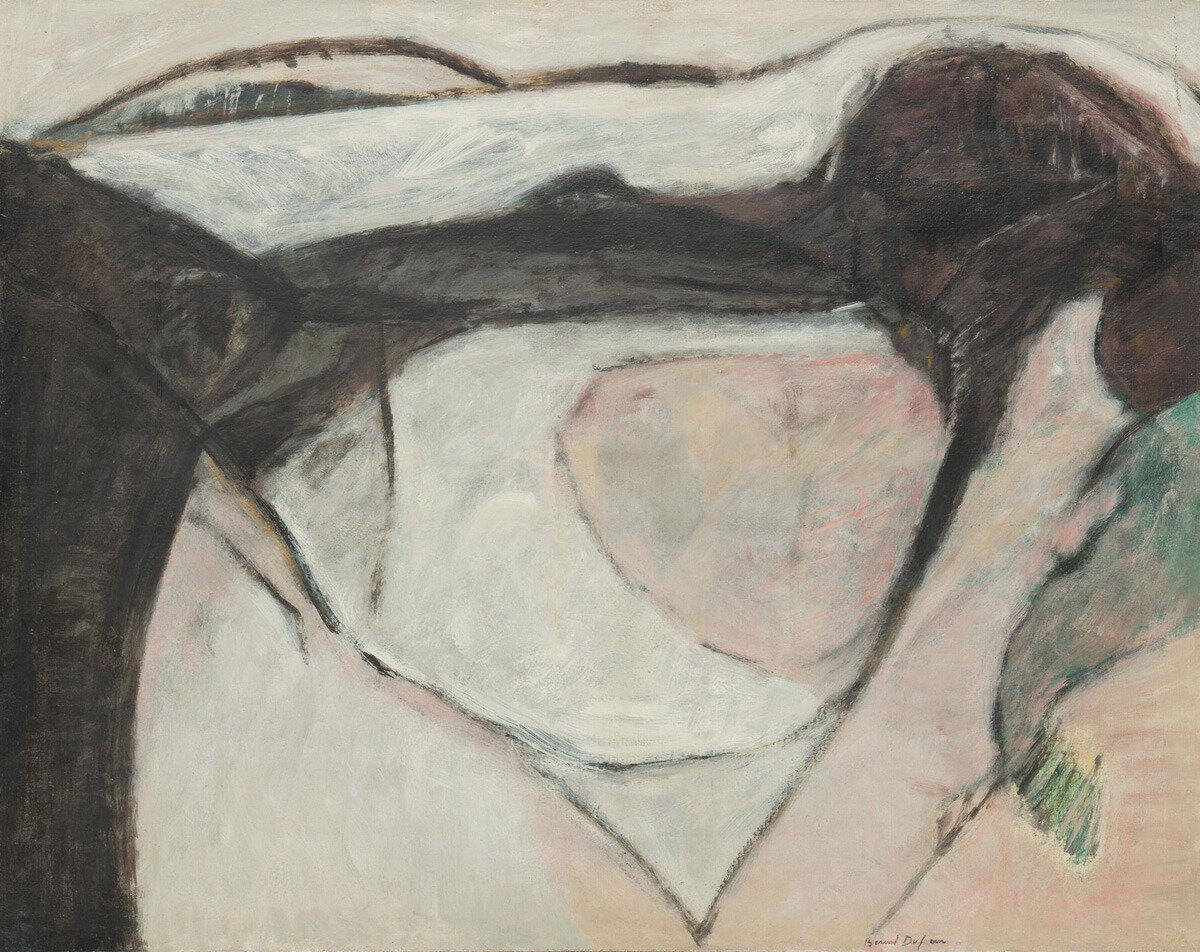
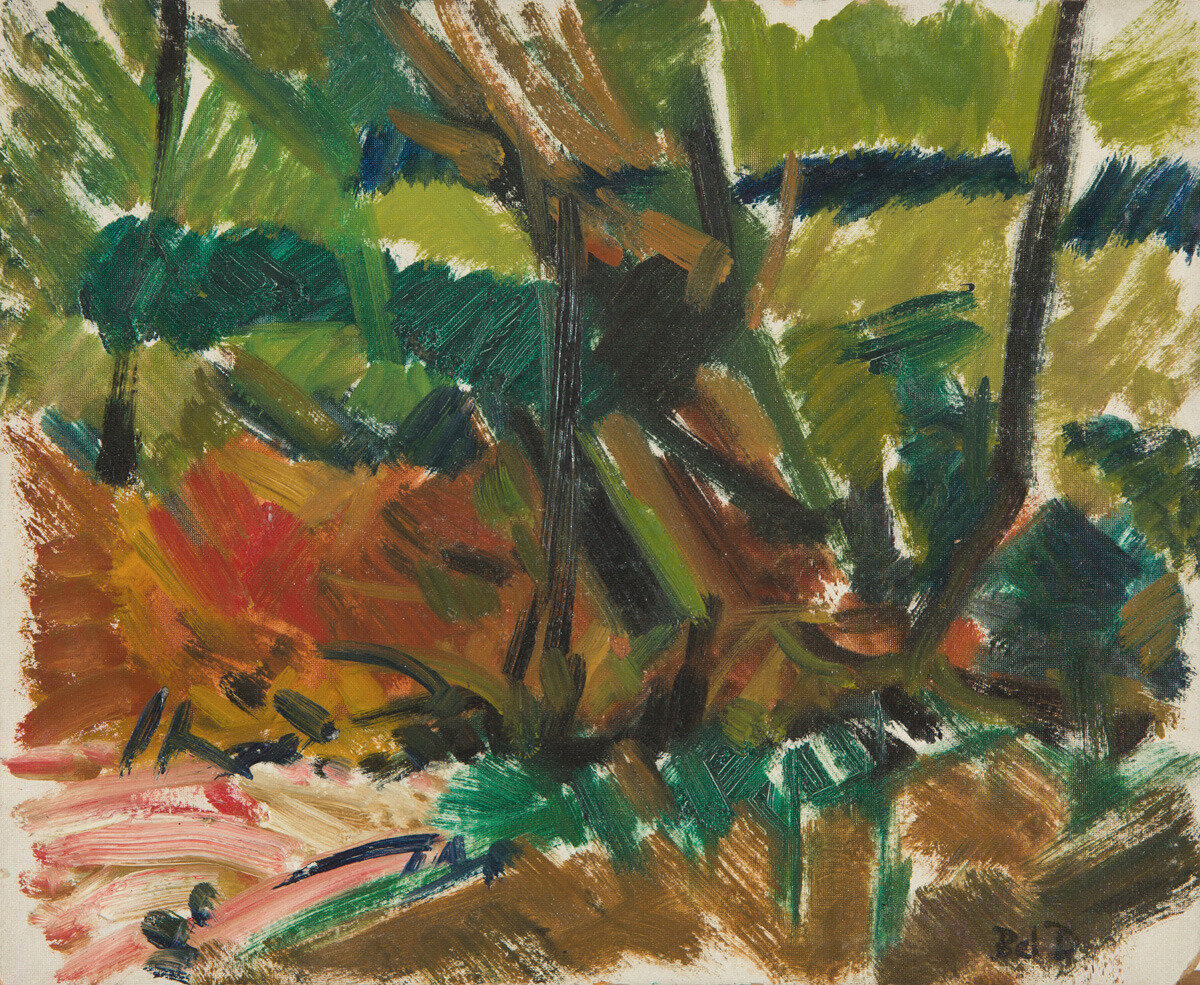
PARIS
25 ANS, hommage à Bernard Zürcher /
Exposition Bernard Dufour Nus et Figures 1964-1990
March 11 - 23, 2017
Alors que nous cherchions comment marquer l’étape des vingt-cinq ans d’activité de notre galerie en 2017, nous avons découvert qu’un couple de nos amis, amateurs passionnés et adeptes sans conditions du « coup de cœur » (une qualité que nous apprécions par dessus tout) avaient dans leur collection un ensemble significatif d’œuvres de Bernard Dufour. Nous n’avons pu résister au plaisir de leur demander de nous les confier le temps d’une exposition. Il y avait plusieurs raisons à cela. Retracer l’histoire de la galerie eut été une option naturelle, mais ce « regard sur le passé » ne nous enthousiasmait guère.
Essentiellement galeristes du « premier marché », celui de l’intime conviction qui se forme à l’atelier, notre mouvement naturel est d‘accompagner le plus longtemps possible les artistes sur le chemin de la création en train de se faire et par conséquence animer la galerie ce qui signifie convaincre à notre tour l’amateur d’art du bien fondé de notre conviction.
Une galerie n’est pas un magasin de luxe. C’est une entreprise qui se situe entre le musée (les anglo-saxons utilisent le même mot « gallery » pour désigner aussi bien le musée que la galerie) et ce qu’on appelle aujourd’hui en langage marketing la « boutique inspirée ».
Mais pourquoi cette exposition Bernard Dufour ? Il y avait eu une probabilité que nous ayons pu partager avec Bernard Dufour une histoire commune. Il avait longtemps été représenté par la galerie Beaubourg, puis il lui avait fallu reprendre sa liberté. Marc Desgrandchamps qui l’admirait nous avait alors incité à le rencontrer. Il avait fait sa connaissance chez Sabine Dauré à l’occasion de son exposition en 2002 au Château de Jau. Dufour lui-même le tenait en haute estime puisqu’il lui a rendu hommage dans un tableau, Hommage à Marc Desgrandchamps, à Mathieu Le Nain et au Titien, 2006 ainsi que dans un film autobiographique réalisé par Jorge Amat en 2009.
Bernard Dufour se trouvait d’une certaine manière relié à notre histoire.
Il avait été « découvert » par Pierre Loeb, galeriste renommé, au Salon d’Octobre de Charles Estienne en 1952. Or de manière quasi prémonitoire, avant de quitter définitivement le Palais de Tokyo, achevant ainsi ma courte carrière dans les musées (1978-1986), Michel Hoog, conservateur du musée, m’avait tendu un catalogue en me disant : "Tenez, cela devrait vous intéresser pour votre nouvelle vie". Son titre : "L’Aventure de Pierre Loeb, La Galerie Pierre, Paris 1924-1964", Musée d’art moderne de la Ville de Paris, 7 juin-16 septembre 1979. Dans ce catalogue, une photo montre Pierre Loeb et les trois jeunes artistes de sa dernière équipe : Paul Kallos, Bernard Dufour, Georges Romathier. Pierre Loeb, ami de Picasso avait également monté la première exposition de peinture surréaliste en novembre 1925 et la première exposition Joan Miró en France en 1928. Il avait été aussi très proche de Georges Braque. Aussi quand j’entrepris d’écrire une importante monographie sur Braque (L’Office du Livre, Fribourg et Rizzoli, New York), je me suis senti proche de lui par la pensée. Je rencontrai sa sœur, la photographe Denise Colomb qui m’autorisa à reproduire un de ses portraits de Braque, tel que Pierre Loeb l’avait connu.
Je dois avouer que Bernard Dufour c’était pour moi le Frenhofer du Chef-d’œuvre inconnu de Balzac adapté par Jacques Rivette dans son film « La Belle Noiseuse » en 1991. Il était venu à la galerie à l’occasion de l’exposition de Marc Desgrandchamps en 2005 accompagné de sa dernière compagne qui était aussi son modèle, Laure Sérullaz, la fille de Maurice Sérullaz conservateur du Cabinet des Dessins du Louvre et sa femme Arlette directrice du musée Delacroix, que j’avais connus au musée.
Mais je me souviens surtout de ma rencontre avec lui en 1997, à l’occasion de son exposition à la galerie Sollertis de Toulouse. Il m’avait impressionné par sa prestance comme par son érudition et la finesse de ses jugements.
Nous avions évoqué le souvenir de Pierre Loeb qui l’avait accompagné jusqu’à sa mort en 1964. Pour moi il devint clair que Marc Desgrandchamps que nous avons accompagné pendant vingt ans depuis sa première exposition à la galerie en 1995 était ce « fils spirituel » que Bernard Dufour appelait de ses vœux dans ses entretiens avec Fabrice Hergott, entretiens que ce dernier a publié en 2010 sous forme d’une monographie remarquable et très bien illustrée aux Editions de la Différence.
Aussi cette découverte inattendue d’un ensemble de tableaux de Bernard Dufour dans la collection de nos amis tombait bien. Nous avons décidé de faire un pas de côté en créant un événement qui peut sembler curieux : rendre hommage à un peintre à titre posthume (Dufour est mort dans la nuit du 21 juillet 2016), un peintre que nous aurions pu exposer sans pourtant l’avoir fait de son vivant. Ses tableaux sont venus à nous et il nous a aussitôt paru naturel de vouloir les montrer. Je reprendrai ici la première phrase du texte d’André Berne Joffroy dans le fameux catalogue du Musée d’art moderne L’Aventure de Pierre Loeb…Elle me semble particulièrement convenir ici : « Cette exposition a été faite comme un bouquet, avec les fleurs qu’on a trouvées. »
Bernard Zürcher
Éléments de Bibliographie :
L’Aventure de Pierre Loeb, la Galerie Pierre, Paris, 1924-1964. Catalogue de l’exposition du Musée d’art moderne de la Ville de Paris, 7 juin -16 septembre 1979. Préface de Bernadette Contensou et Jean Coquelet. Témoignages de Jean Cassou, Joan Miro, Roland Penrose, Jacques Lassaigne, André Pieyre de Mandiargues, Pierre Bruguière, Lucien Durand, Wifredo Lam, Henriette Gomès.
Fabrice Hergott, Bernard Dufour, Editions de la Différence, Paris, 2010. Ce livre contient une bibliographie et une filmographie essentielles.
Jacques Henric et Catherine Millet (préface de Laurent Perez), Bernard Dufour (Les grands entretiens d’artpress), Paris, 2015.
Catherine Millet, Bernard Dufour, l’oeil du désir, Editions de la Différence, Paris, 2015.
Filmographie :
Philippe Dufour, Bernard Dufour, Le Mas de Pradié, 1988, 28’ (Philippe Dufour est le fils de Bernard Dufour.)
Jorge Amat, Confidences de Bernard Dufour, Utopiart films, 2009, 39’05 (Jorge Amat est un réalisateur de cinéma et de télévision, fils de Federico Melchor, dirigeant communiste Espagnol et de la peintre Victoria Amat, républicains espagnols, émigrés en France après le coup d’état de Franco.)
Quelques jalons
La Galerie Zürcher est établie depuis 1992 à Paris, 56 rue Chapon.
Depuis mars 2009, l’histoire de la galerie s’est dédoublée à New York au 33 Bleecker Street près du New Museum dans l’ancien atelier du sculpteur Joël Shapiro. New York, cela faisait 15 ans que nous y allions régulièrement à l’occasion des foires et pour visiter Bruno Rousselot, à l’époque jeune peintre abstrait qui était représenté par la galerie et avait eu le courage de s’expatrier, prenant le risque de louer un atelier sous le pont de Brooklyn. Il avait assisté Sol LeWitt pour ses wall drawings et en retour celui-ci lui avait présenté Léo Castelli et une galerie : Lennon Weinberg. Mais la première personne à nous avoir conseillé de nous installer à New York fut Joan Mitchell, dont nous étions voisins à Vétheuil. Nous avons également reçu l’aide chaleureuse d’Ahmet Ertegun, le fondateur du label Atlantic Records, client et ami enthousiaste qui a donné un dîner privé dans sa maison uptown en l’honneur de Marc Desgrandchamps à l’occasion de la première exposition que nous avions organisé à New York. Il y eut aussi cette visite d’Yvon Lambert sur notre stand de la FIAC ayant appris notre projet pour nous faire partager son expérience new yorkaise. Sa démarche nous a conforté dans notre décision.
Notre implantation à New York nous a permis de faire d’heureuses rencontres à commencer par notre voisin, le photographe Robert Frank qui vit au 7 Bleecker Street. Puis la famille de Robert Ryman qui nous a fait progressivement confiance - nous représentons désormais Merrill Wagner, la femme de Robert Ryman, et leur fils Cordy Ryman - enfin nous avons découvert le travail de Regina Bogat née en 1928, nous avons vendu une de ses œuvres les plus importantes au Metropolitan Museum à New York et entamé un projet d’exposition personnelle itinérante dans trois musées américains.
Depuis 2011, nous avons lancé un nouveau projet : le SALON ZÜRCHER, un concept de mini-foire alternative, intime et sélective, positionné en OFF des grandes foires de New York (l’Armory Show début mars et Frieze à la mi-mai) et de Paris (la FIAC mi-octobre).
Tandis que la première édition à New York en mars 2011 pendant l’Armory Show était qualifiée par le New York Times de « spirited selection », la seconde édition à Paris en octobre 2011 pendant la FIAC était désignée comme un « mini art salon » par le Financial Times. Ce modèle de « salon d’art » s’est imposé pour les éditions suivantes. 80 galeries connues pour être investies sur une programmation d’artistes émergents y ont déjà participé. Elles sont originaires d’Amérique, d’Europe et d’Asie, sur invitation de la Galerie Zürcher, Paris / New-York, commissaire et organisateur du salon. En 2017 aux éditions « classiques » viennent s’ajouter un SALON ZÜRCHER PHOTO à New York (28.03 - 2.04.2017) et deux SALON ZÜRCHER AFRICA (Nouveauté) à Paris (27.03 - 2.04.2017) et à New York (2.05 - 6.05.2017).
On the occasion of its 25th anniversary, Galerie Zürcher pays a tribute to Bernard Dufour via the collection of a couple of collector friends.
While looking for a way to celebrate the 25th anniversary of our gallery in 2017, we discovered that a couple of friends, two passionate art lovers and collectors by heart (which we appreciate above all) held a significant collection of works by Bernard Dufour. For several reasons, we could not resist the pleasure to borrow it the time of an exhibition. Looking back at the gallery history would have been the most obvious way to celebrate, but this “nostalgic” approach did not speak to us. As a gallery mostly acting on the first market, we trust in what happens within the four walls of a workshop, and our mission is to bring a long-term support to artists who follow the path of living creation. In turns, it means keeping the gallery alive and convincing art aficionados of the validity of our artistic proposals.
A gallery is no luxury store. It stands mid-way between a museum (the term “gallery” refers to both museums and art galleries) and what today we call an “inspired store”.
But why exhibit Bernard Dufour ? Our path could have crossed many times in the past. For a while and before he claimed his freedom back, he was represented by the Galerie Beaubourg. Marc Desgrandchamps, who admired him, encouraged us to meet him. He had himself met him at Sabine Dauré on the occasion of her exhibition at the Château de Jau in 2002. Dufour thought highly of him in return since he paid the artist a tribute in a painting entitled Hommage à Marc Desgrandchamps, à Mathieu Le Nain et au Titien (2006) as well as in an autobiographical film produced by Jorge Amat in 2009.
Here is how Bernard Dufour was somehow connected to our history. It was the renowned gallery owner Pierre Loeb who discovered him at the Salon d’Octobre of Charles Estienne in 1952. In a strangely premonitory way, before I left the Palais de Tokyo and put an ending note to my short museum career (1978-1986), Michel Hoog, the museum curator, offered me a catalog and said : ”Here, take it, that should be interesting for you in your new life”. Its title ? “L’Aventure de Pierre Loeb, La Galerie Pierre, Paris 1924-1964", Musée d’art moderne de la Ville de Paris, June 7th-September 16th, 1979. In this catalogue, there was a picture of Pierre Loeb with the three young artists of his last team : Paul Kallos, Bernard Dufour and Georges Romathier. Friend of Picasso, Pierre Loeb also held the first exhibition of surrealist painting in November 1925 as well as the first French exhibition of Joan Miró in 1928. Besides, he was intimate with Georges Braque. This is why I bore him in mind when I started writing a monographic book on Braque (L’Office du Livre, Fribourg&Rizzoli, New York). Then I got to meet his sister, the photographer Denise Colomb, who allowed me to reproduce her portraits of Braque as Pierre Loeb knew him.
I must admit that for me, Bernard Dufour was the Frenhofer of Balzac’s Unknown Masterpiece adapted by Jacques Rivette in his 1991 movie entitled “La Belle Noiseuse”. He had come to the gallery for Marc Desgrandchamps 2005 exhibition with his last partner who was also a model : Laure Sérullaz, the daughter of Maurice Sérullaz, curator of the drawing department of the Louvre and his wife, Arlette, Director of the Musée Delacroix, who I had met at the museum. But I mostly remember my encounter with him during his exhibition at the Sollertis gallery in 1997, in Toulouse. I was impressed by his presence as well as his knowledge and the fineness of his opinions. We talked about Pierre Loeb who had supported him until his death in 1964. It became clear to me that Marc Desgrandchamps, who we had been representing for 20 years since his first exhibition at the gallery in 1995, was the “spiritual son” Bernard Dufour mentioned in his interview with Fabrice Hergoot published in a remarkable and very well illustrated monographic book at the Editions de la Différence in 2010.
This is why the unexpected discovery that our friends owned a collection of paintings by Bernard Dufour happened at a very good time. We decided to take a side step and what might look like a strange initiative : paying a posthumous tribute (Dufour passed away on the night of July 21st, 2016) to a painter we could have exhibited during his lifetime but never did. His paintings simply came to us and we wanted to showcase them. The first sentence of André Berne Joffroy in the above-mentioned catalogue by the Musée d’art moderne L’Aventure de Pierre Loeb… seems particularly appropriate here : “this exhibition is like a bouquet, we made it with the flowers we found”.
Bernard Zürcher
Bibliography :
L’Aventure de Pierre Loeb, la Galerie Pierre, Paris, 1924-1964. Musée d’art moderne de la Ville de Paris exhibition catalogue, June 7th - September 16th, 1979. Prefaced by Bernadette Contensou and Jean Coquelet. With testmonials of Jean Cassou, Joan Miro, Roland Penrose, Jacques Lassaigne, André Pieyre de Mandiargues, Pierre Bruguière, Lucien Durand, Wifredo Lam, and Henriette Gomès.
Fabrice Hergott, Bernard Dufour, Editions de la Différence, Paris, 2010. The bibliography and filmography of this book is crucial.
Jacques Henric et Catherine Millet (prefaced by Laurent Perez), Bernard Dufour (Les grands entretiens d’artpress), Paris, 2015
Catherine Millet, Bernard Dufour, l’oeil du désir, Editions de la Différence, Paris, 2015
Filmography :
Philippe Dufour, Bernard Dufour, Le Mas de Pradié, 1988, 28’
Philippe Dufour is Bernard Dufour’s son.
Jorge Amat, Confidences de Bernard Dufour, Utopiart films, 2009, 39’05
Jorge Amat is a movie and television maker, son of Federico Melchor, Spanish communist leader and painter Victoria Amat, Spanish republicans emigrated in France after Franco’s coup.
A few milestones
Galerie Zürcher opened its doors in Paris, 56 rue Chapon (3rd ar.), in 1992. As our exhibition history shows (1992-2017), our gallery discovered and supported a great number of artists and allowed some of them, such as French painter Marc Desgrandchamps and Chinese sculptor Wang Keping, to reach international exposure.
In March 2009, the gallery opened a new chapter in New York, on 33 Bleecker Street, near the New Museum and in the former workshop of sculptor Joël Shapiro. During fifteen years, we used to regularly fly to New York to attend art fairs and visit Bruno Rousselot, a young abstract painter we represented back then. He had had the courage to move to the United States and take the risk to rent a workshop under Brooklyn Bridge. Working as an assistant for Sol LeWitt on his wall drawings, the latter introduced him to Leo Castelli and the Lennon Weinberg gallery. However the first person to suggest we settled in New York was Joan Mitchell, our neighbor in Vétheuil. We also received the warm support of Ahmet Ertegun, founder of the Atlantic Records label, a client and dear friend of ours. On the occasion of the first exhibition we held in New York, he organized a private dinner party in his uptown mansion in honor of Marc Desgrandchamps. There was also Yvon Lambert who heard about our project and came to share his New York experience with us on our booth at the FIAC. He only comforted us in our decision.
Today, we run our gallery between Paris and New York. In 2011, we launched a new concept : the SALON ZÜRCHER, an alternative, intimate and selective, mini-fair concept conceived like an OFF event of New York and Paris big art fairs such as the Armory Show (March), Frieze (mid-May) and Fiac (mid-October).
While The New York Times described our first New York edition held during the Armory Show in March 2011 as a “spirited selection”, “mini art salon” was the expression used by The Financial Times about the second one we held in October 2011 during FIAC in Paris.
We kept this “mini art fair” format for the following editions. 80 galleries known to support emerging artists have already attended. Invited by the Galerie Zürcher, Paris/New York, curator and organizer of the event, they have come from America, Europe and Asia. In 2017, on top of our usual editions, we will hold a SALON ZÜRCHER PHOTO in New York (03.28-04.02) as well as two SALON ZÜRCHER AFRICA in Paris (03.27-04.02) and New York (05.02-05.06).
